-
Car Reviews
- All reviews
- Midsize SUVs
- Small cars
- Utes
- Small SUVs
- Large SUVs
- Large cars
- Sports SUVs
- Sports cars
- Vans
Latest reviews
- Car News
-
Car Comparisons
Latest comparisons
- Chasing Deals
After almost 20 years of R-badged Golfs, the fifth-generation model finally steps out of the GTI’s shadow to become the hard-edged hot hatch it always deserved to be

The Volkswagen Golf R (and its R32 predecessor) has always had the stylistic sizzle to support its status as the alpha male of VW’s evergreen Golf line-up, though the reality hasn’t always lived up to that lofty positioning.
Right up until the final Mk7.5 Golf R (launched late-2017), the Golf GTI had long been a more rewarding driver’s car, with greater handling involvement for a much sharper price. But something happened with the Mk7.5 – nudging the Golf R ahead of its front-drive GTI cousin to finally justify its price premium from an enthusiast’s perspective, making it the perfect stepping stone to the next-generation Mk8 Golf R.
While the regular Golf 8 is clearly an evolution of the Mk7’s circa-2012 underpinnings and overall structure, the new Golf R has actually been given more room to breathe. Instead of sharing its AWD system and general mechanical package with the slightly more expensive Audi S3, the $65,990 Mk8 Golf R leapfrogs the S3’s power output (235kW versus 228kW) while incorporating the twin-clutch rear differential hardware from the ballistic five-cylinder Audi RS3 to create a rather unique performance package – one that is substantially different from the $11,500-cheaper, front-drive Golf GTI.
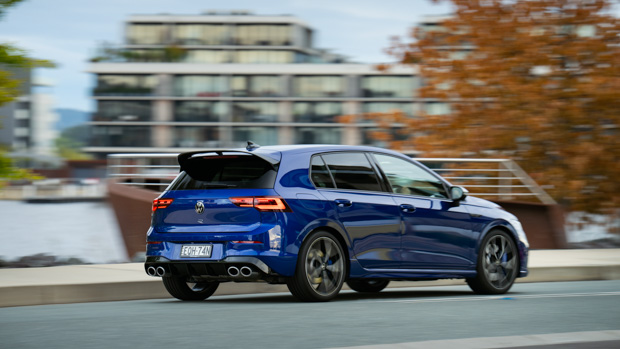
To broaden the previous Golf R’s sporting appeal, Volkswagen Australia offered the Mk7.5 version in both regular and Grid Edition versions – the latter with a lower equipment level, tartan-cloth seats and a manual transmission.
While motoring journos and VW’s own staff loved the purity of the Grid Edition, customers didn’t – they much prefer their Golf Rs fully loaded – so the Mk8 Golf R arrives here in a single premium spec with standard R Performance Package, part-leather interior and seven-speed dual-clutch transmission. A manual Golf R is only available in the US and Canada.
Yet thanks to the semi-conductor supply nightmare affecting global vehicle production, the 2022 Golf R isn’t quite what VW Oz originally planned.
As with the new Tiguan R, in order to secure consistent volume, the panoramic sunroof ($2000) and Harman-Kardon stereo ($1000) have been moved to the options list, which could make sense for a lot of people.
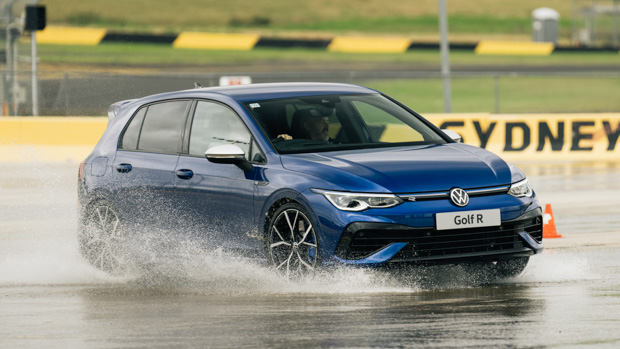
Our test Golf R hatch featured the trick sound system but not the sunroof – exactly the spec I would choose – and if you only ever listen to AM radio, why bother with the Harman-Kardon?
VW is also hedging its bets by offering a new Golf R wagon for exactly the same price as the new Tiguan R ($68,990 before on-road costs) – giving buyers the choice of either a traditional fast station wagon or a hot-shot SUV.
Unlike the Golf R hatch, however, the R wagon arrives here with the European engine tune (not the international one) and a petrol particulate filter for improved consumption (7.4L/100km versus 7.8 for the Golf R hatch) and stronger torque (420Nm from 2000-5550rpm versus 400Nm from 2000-5600rpm in the Golf R hatch and Tiguan R).
As of mid-April, the Golf R wagon has only just started arriving at the docks, so the variant we tested was a dual-clutch Golf R hatch.
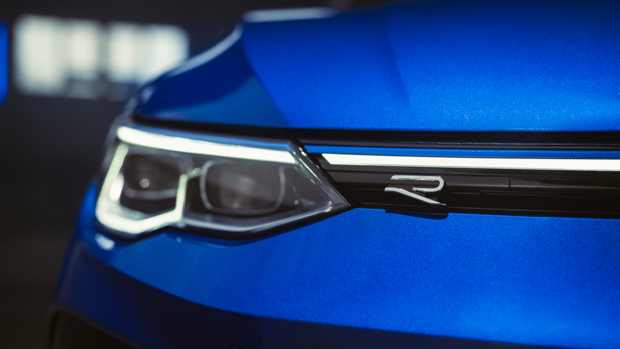
Two things define the new-gen Golf R driving experience – its uprated engine and its new AWD system with twin-clutch rear differential (instead of the Haldex version used by the Audi S3 and previous Golf Rs).
While the core DNA of the new Golf R’s EA888-series 2.0-litre turbo-petrol four is the same as the previous model’s, outputs have jumped significantly.
Our Mk8 Golf R hatch (plus the Tiguan R) features an international-market tune for the tricked-up engine (with three-way catalytic converter, not the R wagon’s PPF) – lifting power from 213kW to a rousing 235kW (from 5600-6500rpm) and increasing torque by 20Nm to 400Nm (from 2000-5600rpm).
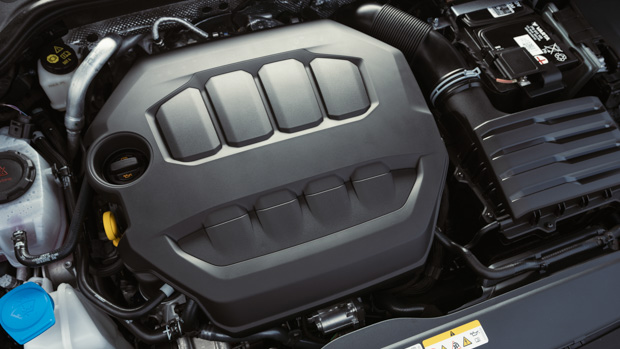
The official 0-100km/h claim for the Australian Golf R hatch is 4.8 seconds – a number very similar to previous generations (and marginally down on the 4.7sec of the European R hatch) – but acceleration feels really strong, and on a good day, it should easily be able to beat that figure.
Noise-wise, the Golf R is pleasantly bassy and tuneful, despite having a synthesised induction note, though you can select ‘Pure’ for engine sound in the Individual drive-mode to silence the tech overlay and let the R’s exhaust blurting do the talking.
But performance and engine theatrics have rarely been an issue with the Golf R – it’s been dynamics that have managed to undermine its status as the primo Golf. Where the front-drive GTI could feel playful and involving – adjusting its line with an oversteer nudge from the tail – the Golf R was so planted it could seem comparatively boring, especially the Mk6. But not anymore.

Thanks to a twin-clutch rear axle (shared with the new Audi RS3, and identical in nature to the hardware beneath the rear end of the latest Mercedes-AMG A45 S and old Ford Focus RS), the Golf R now has the smarts to deliver a deeply involving driving experience.
Controlled via a series of new drive modes (including a Sport mode it defaults to after start-up, plus Comfort, Race, Individual, Special and Drift) and a new Vehicle Dynamics Manager that oversees the integration of all this fancy dynamic hardware and software, the twin-clutch rear can send 100 percent of drive to either rear wheel – delivering true torque vectoring, rather than simply braking an inside wheel.
The effect is a level of tight-corner adjustability and pivot-ability that elevates the Golf R’s dynamic personality far beyond its forebears. It also makes the steering feel keenly fast-geared (despite some on-centre vagueness), masking the rather large turning circle.
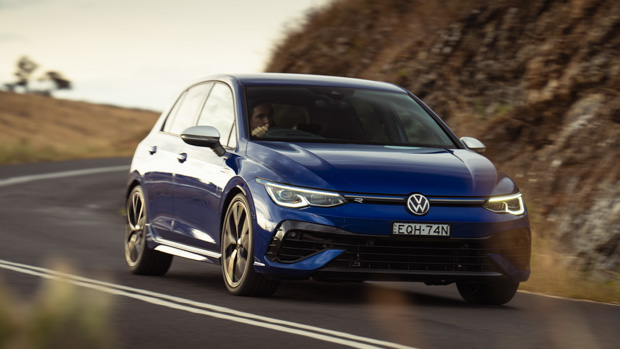
On the road, it makes the Golf R feel much smaller than it actually is, and will even produce oversteer punching out of corners. Then there’s the Golf R’s T-junction entry theatrics, which is a riot of drive management thrusting it 90 degrees with addictively hilarious results. It’s a fine combination of hooligan flavour supported by an AWD/ESC Sport safety net.
Around the north circuit of Sydney Motorsport Park with the drive mode set to Race, the twin-clutch rear axle works in a similar fashion to a great front LSD – pointing the nose into a corner apex and allowing for tremendous traction on exit.
The new Tiguan R might be hugely accomplished but the Golf R feels lighter (which it is, by 220kg!), sharper, keener, and all-round better. The fact you’re sitting so much lower to the ground makes a big difference, and the same R Performance brakes (357mm vented/drilled front discs with two-piston calipers, 310mm vented rear discs) don’t have to work as hard to pull up the rapid Golf.

In general driving out in the real world, the adaptively damped Golf R is a firmly suspended car, though Sport mode treads a respectably fine line between offering sharpness without destroying the ride. Indeed, given that’s the mode it selects every time after start-up, I drove the Golf R in Sport mode most of the time, and only switched to Comfort on poorer sections of highway. That said, even Comfort can’t achieve what it promises over scarred urban roads – this is a fast, focused hot hatch.
Safety-wise, the Golf R brings not only an AWD chassis with highly effective stability-control calibration but a raft of active-safety kit including Travel Assist with adaptive lane guidance (which groups together a bunch of safety electronics to enhance freeway driving ease), as well as side assist with lane-changing assistant, rear AEB and rear cross-traffic alert, traffic-jam assist and adaptive cruise control.
The R treatment inside the Golf R goes a bit further than it does in the Tiguan R.
There’s a lot of equipment that is shared, like a sports steering wheel with a chunky rim, blue stitching and perforated sections where you put your hands. Like the Tiguan R, the hottest Golf also gets oversized matte-anthracite wheel paddles, where if you hold the left one pulled forward, the Golf R will downshift to the lowest-possible gear.
The capacitive wheel buttons are a love-it-or-hate-it thing, though you do get used to them over time. As with any Mk8 Golf, you need to be willing to try and master the electronic systems and interfaces inside the car. There’s an R button on the left wheel spoke that brings up the Drive Modes on the 10.0-inch touchscreen with a light press, or directly selects ‘Race’ mode with a more determined poke, as well as accessing Drift and Special modes.
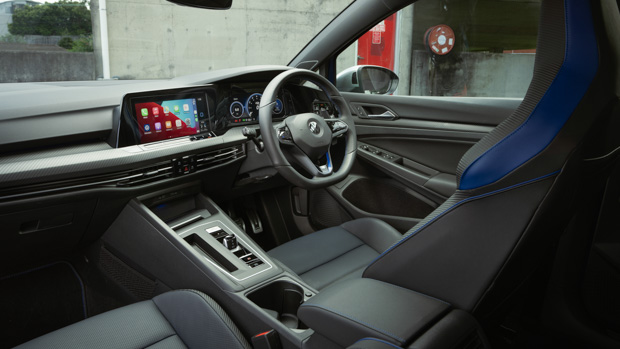
What the Golf R does a lot better than the Tiguan R is add a level of expense to its driver environment. It has a bunch of configurable screens for its more sophisticated Digital Cockpit, as well as different colours depending on which drive mode you’re in, and it makes the Golf feel newer and classier.
As for the centre touchscreen/control interface, which groups together so many core functions, it takes quite a lot of getting used to and its processing speed can be patchy, but does work better over time. You can configure a four-button shortcut screen that scrolls down from the top – adding stuff like the idle-stop system or the ESC Sport button (which is otherwise buried super-deep in the screen menus).
The Golf R does get wireless phone charging (unlike Tiguan R), and the optional 490-watt, 10-speaker Harman-Kardon sound system with subwoofer (that takes up the underfloor space in the boot) and wireless Apple CarPlay/Android Auto sounds really strong and is well worth the $1000 outlay.
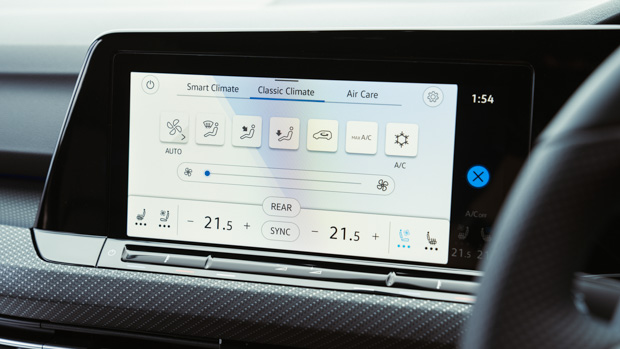
As for the Golf R’s front seats, they’re superb fully-electric winged buckets with perforated Nappa leather facings. Unlike the Tiguan R’s rather flat front seats, these are super-huggy and perfectly in keeping with the Golf R’s dynamic flavour. They also offer excellent three-setting seat cooling and heating, though I think the blue tartan cloth of the European seats looks cooler and fits the hot-Golf vibe with its acres of blue stitching better.
Since at least the Mk7, the rear seat of a Golf has been a really good place to be and this Golf R is no different, although it does carry over some of the stuff that has been criticised about the Mk8. For example, there’s lots of hard plastic around the centre air vents (with their own temperature control above two rear USB-C ports) and there is definitely a lowering of tone in the rear row.
Despite offering two smartphone pockets and a pair of mat pockets, the backs of the front seats are hard-wearing vinyl – just like most of the rear seat upholstery (apart from flat-leather centre inserts, which is clearly decontented from the perforated Nappa offered up front). The doors are rock hard and don’t have the same slight amount of cushiness as the front doors, but the door bins are still carpeted and take large bottles, and the rear bench retains the cool carbon-fibre-esque trim detailing.
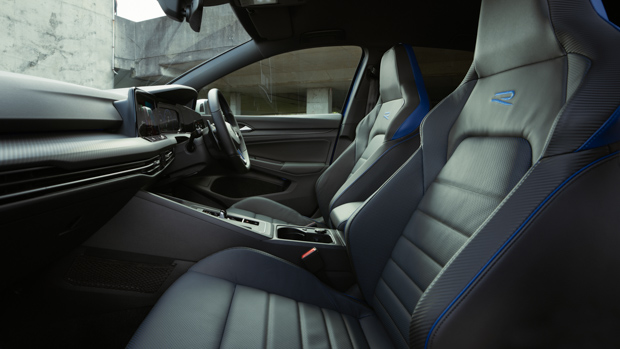
Rear seat comfort is also excellent, with great lumbar support, really good side support, and plenty of under-thigh support, as well as ample foot-, leg- and head-room.
The tombstone front seats are a little bit in your way, but there’s still loads of all-round vision and even the centre seat is comfortable. So like any modern Golf, you can arguably fit three adults in the back. And with a 374-litre boot, there’s good luggage space.
That said, if you want proper room aft of the B-pillar, go for the Golf R wagon. Not only does it have a 50mm-longer wheelbase than the hatch for even greater rear-seat space, but it offers 611 litres of luggage space and a better-shaped boot than the Tiguan R.
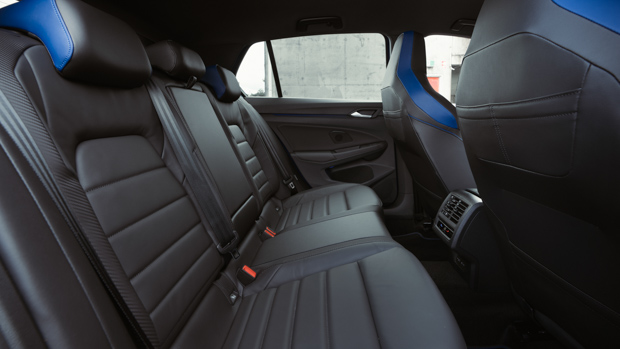
The combined ADR81/02 fuel consumption figure for the Golf R hatch is 7.8L/100km using 98-octane premium fuel, which is marginally thirstier than the 7.4L/100km combined figure for the Golf R wagon. During our testing, the Golf R hatch averaged 9.0L/100km.
Recommended service intervals for the Golf R occur every 12 months or 15,000km, with Volkswagen’s capped-price servicing packages covering three years ($1700) or five years ($3000). This compares to $1650 for three years and $3100 for five years for the new Tiguan R.
Volkswagen Australia’s warranty is five years/unlimited kilometres – standard practice for a mainstream manufacturer.
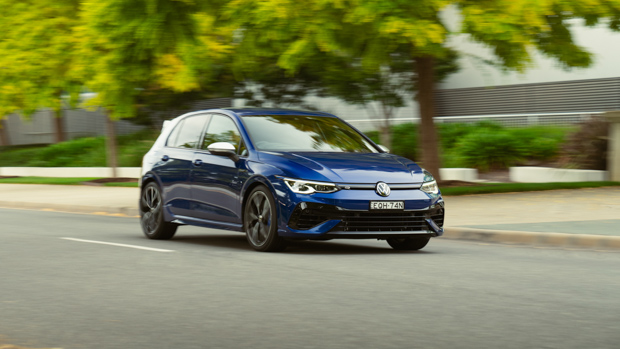
When you think about the fact that the Golf R only costs $65,990 (before on-road costs) – despite still being a substantial amount of money – it’s actually pretty decent value when compared to its German and European competitors. The only option you really need to add, in our opinion, is the $1000 Harman-Kardon stereo, or choose the arguably even more appealing Golf R wagon for three grand more.
Is it a shame that the Golf R manual isn’t coming to Australia? Not when you consider how great the ‘wet’ seven-speed dual-clutch is, with its trademark exhaust-blurting adding to the Golf’s sporting allure.
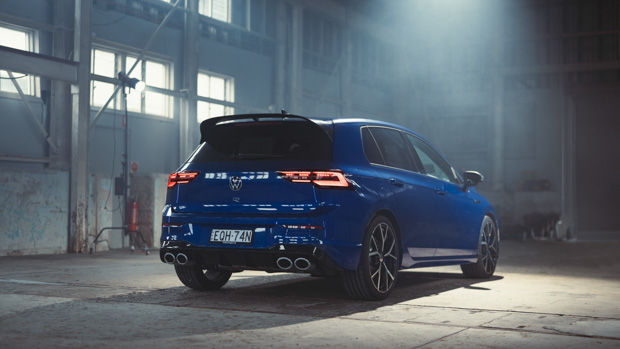
Indeed, the Mk8 Golf R is brimming with character, but it’s also the most uncompromising Golf yet. It has a tremendous amount of bandwidth when it comes to agility – especially in tight corners – and it adds an extra layer of comfort and expense with its beautifully-trimmed, superb supportive sports front seats. But it’s also a very focused car.
You need to be willing to put up with a pretty firm ride, and while the Golf R remains a high-performance hatch that is intended to deliver fun for everybody, exploring the considerable limits of its performance and handling means it’s not really a car for the faint hearted. But maybe that’s the beauty of the Mk8 Golf R – the more you ask of it, the more it delivers.
Variant tested R 4MOTION
Key specs (as tested)
About Chasing cars
Chasing Cars reviews are 100% independent.
Because we are powered by Budget Direct Insurance, we don’t receive advertising or sales revenue from car manufacturers.
We’re truly independent – giving you Australia’s best car reviews.
The estimate provided does not take into account your personal circumstances but is intended to give a general indication of the cost of insurance, in order to obtain a complete quote, please visit www.budgetdirect.com.au. Estimate includes 15%^ online discount.
^Conditions Apply
Budget Direct Insurance arranged by Auto & General Services Pty Ltd ACN 003 617 909(AGS) AFSL 241 411, for and on behalf of the insurer, Auto & General Insurance Company Limited(ABN 42 111 586 353, AFSL 285 571).Because we don’t know your financial needs, we can’t advise you if this insurance will suit you. You should consider your needs and the Product Disclosure Statement before making a decision to buy insurance. Terms and conditions apply.
Indicative quote based on assumptions including postcode , 40 year old male with no offences, licence suspensions or claims in the last 5 years, a NCD Rating 1 and no younger drivers listed. White car, driven up to 10,000kms a year, unfinanced, with no modifications, factory options and/or non-standard accessories, private use only and garaged at night.
^Online Discounts Terms & Conditions
1. Discounts apply to the premium paid for a new Budget Direct Gold Comprehensive Car Insurance, Third Party Property Only or Third Party Property, Fire & Theft Insurance policy initiated online on or after 29 March 2017. Discounts do not apply to optional Roadside Assistance.
2. Discounts do not apply to any renewal offer of insurance.
3. Discounts only apply to the insurance portion of the premium. Discounts are applied before government charges, taxes, levies and fees, including instalment processing fees (as applicable). The full extent of discounts may therefore be impacted.
4. We reserve the right to change the offer without notice.